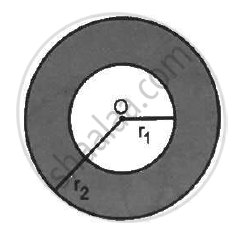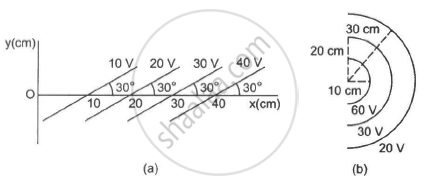Advertisements
Advertisements
Question
A charge Q is placed at the centre of an uncharged, hollow metallic sphere of radius a. (a) Find the surface. (b) If a charge q is put on the sphere, what would be the surface charge densities on the inner and outer surfaces? (c) Find the electric field inside the sphere at a distance x from the centre in the situations (a) and (b).
Solution
Given:
Amount of charge present at the centre of the hollow sphere = Q
We know that charge given to a hollow sphere will move to its surface.
Due to induction, the charge induced at the inner surface = −Q
Thus, the charge induced on the outer surface = +Q
(a)
Surface charge density is the charge per unit area, i.e.
`sigma = ("charge")/ "total surface area" `
Surface charge density of the inner surface,
`sigma_"in" = -"Q"/(4 pi "a"^2)`
Surface charge density of the outer surface,
`sigma _"out" = "Q"/(4 pi "a"^2) `
(b)
Now if another charge q is added to the outer surface, all the charge on the metal surface will move to the outer surface. Thus, it will not affect the charge induced on the inner surface. Hence the inner surface charge density,
`sigma _"in" = -"q" / (4 pi "a"^2)`
As the charge has been added to the outer surface, the total charge on the outer surface will become (Q+q).
So the outer surface charge density,
`sigma _"out" = ("q"+ "Q")/(4 pi "a"^2) `
(c)
To find the electric field inside the sphere at a distance x from the centre in both the situations,let us assume an imaginary sphere inside the hollow sphere at a distance x from the centre.
Applying Gauss's Law on the surface of this imaginary sphere,we get:
`oint "E" ."d""s" = "Q"/∈_0`
`"E" oint "d""s" = "Q"/∈_0`
`"E" ( 4 pi "x"^2) = "Q"/∈_0`
`"E" = "Q"/∈_0 xx 1/ (4 pi "x"^2) = "Q"/( 4 pi ∈_0 "x"^2)`
Here, Q is the charge enclosed by the sphere.
For situation (b):
As the point is inside the sphere, there is no effect of the charge q given to the shell.
Thus, the electric field at the distance x:
`"E" = "Q" / 4 pi ∈_0 "x"^2`
APPEARS IN
RELATED QUESTIONS
Why is the potential inside a hollow spherical charged conductor constant and has the same value of as on its surface?
A charge Q is uniformly distributed over a large plastic plate. The electric field at a point P close to the centre of the plate is 10 V m−1. If the plastic plate is replaced by a copper plate of the same geometrical dimensions and carrying the same charge Q, the electric field at the point P will become
A metallic particle with no net charge is placed near a finite metal plate carrying a positive charge. The electric force on the particle will be
The electric field in a region is given by
`vec"E"= 3/5"E"_0 vec"i" + 4/5 "E"_0 vec "i" "with" " E"_0 = 2.0 xx 10^3 "N""C"^-1.`
Find the flux of this field through a rectangular surface of area 0⋅2 m2 parallel to the y-z plane.
A charge Q is placed at the centre of an imaginary hemispherical surface. Using symmetry arguments and Gauss's Law, find the flux of the electric field due to this charge through the surface of the hemisphere in the following figure.

The radius of a gold nucleus (Z = 79) is about 7.0 × 10-10 m. Assume that the positive charge is distributed uniformly throughout the nuclear volume. Find the strength of the electric field at (a) the surface of the nucleus and (b) at the middle point of a radius. Remembering that gold is a conductor, is it justified to assume that the positive charge is uniformly distributed over the entire volume of the nucleus and does not come to the outer surface?
A charge Q is distributed uniformly within the material of a hollow sphere of inner and outer radii r1 and r2 (see the figure). Find the electric field at a point P at a distance x away from the centre for r1 < x < r. Draw a rough graph showing the electric field as a function of x for 0 < x < 2r2 (see the figure).

Consider the following very rough model of a beryllium atom. The nucleus has four protons and four neutrons confined to a small volume of radius 10−15 m. The two 1 selectrons make a spherical charge cloud at an average distance of 1⋅3 ×10−11 m from the nucleus, whereas the two 2 s electrons make another spherical cloud at an average distance of 5⋅2 × 10−11 m from the nucleus. Find three electric fields at (a) a point just inside the 1 s cloud and (b) a point just inside the 2 s cloud.
One end of a 10 cm long silk thread is fixed to a large vertical surface of a charged non-conducting plate and the other end is fastened to a small ball of mass 10 g and a charge of 4.0× 10-6 C. In equilibrium, the thread makes an angle of 60° with the vertical (a) Find the tension in the string in equilibrium. (b) Suppose the ball is slightly pushed aside and released. Find the time period of the small oscillations.
A uniform electric field of 10 N C−1 exists in the vertically downward direction. Find the increase in the electric potential as one goes up through a height of 50 cm.
Some equipotential surface is shown in the figure. What can you say about the magnitude and the direction of the electric field?

Consider a circular ring of radius r, uniformly charged with linear charge density λ. Find the electric potential at a point on the axis at a distance x from the centre of the ring. Using this expression for the potential, find the electric field at this point.
Answer the following question.
Prove that the average energy density of the oscillating electric field is equal to that of the oscillating magnetic field.
A simple pendulum consists of a small sphere of mass m suspended by a thread of length l. The sphere carries a positive charge q. The pendulum is placed in a uniform electric field of strength E directed vertically downwards. Find the period of oscillation of the pendulum due to the electrostatic force acting on the sphere, neglecting the effect of the gravitational force.
When a comb rubbed with dry hair attracts pieces of paper. This is because the ______.
A charge Q is applied to a conducting sphere of radius R. At the sphere's centre, the electric potential and electric field are respectively
